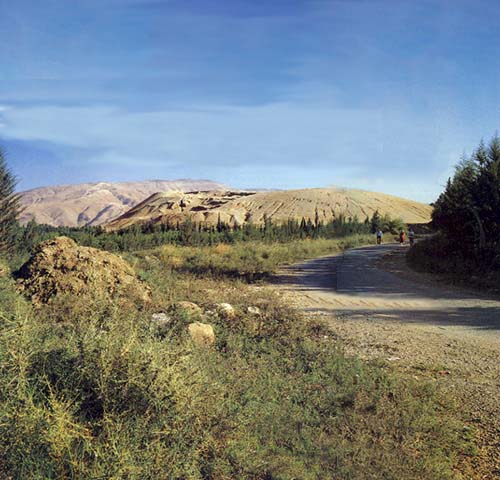
The date was March 17, 1967, a Friday. A Dutch expedition led by Professor Henk J. Franken of the University of Leiden was excavating a mound named Tell Deir Alla in the middle Jordan Valley, east of the river, in Jordan. The site lay halfway between the Sea of Galilee and the Dead Sea, barely a mile north of what was known in Biblical times as the Jabbok River and now is called the Zerqa, a tributary of the Jordan.
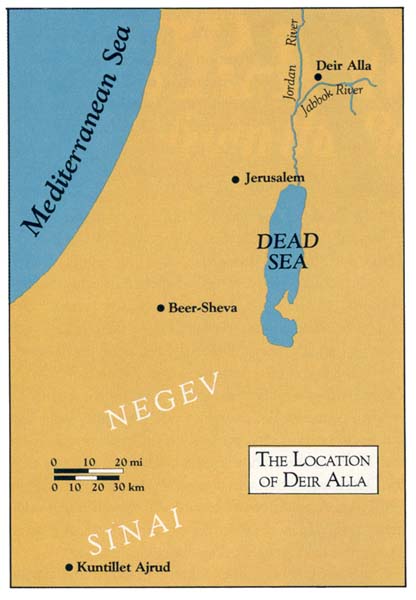
Some scholars have identified Deir Alla with Biblical Succoth, where Jacob built a house for himself and booths (succoth) for his cattle (Genesis 33:17). My own view, as I shall explain, is that the tell is Biblical Penuel, where Jacob wrestled with the angel (Genesis 32:25–32). Of one thing we may be certain: During the eighth to seventh centuries B.C., long after Jacob’s time, Deir Alla was an important city, probably more than ten acres in size. It was in the archaeological levels from this city that the Dutch expedition was digging on that fateful Friday in 1967. An Arab foreman named Ali Abdul-Rasul suddenly noticed traces of letters on tiny pieces of plaster among the debris the workers were cleaning up.
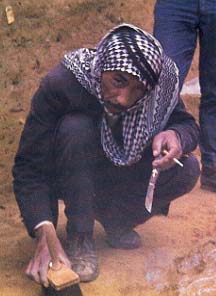
Excitement spread like wildfire through the camp. Excavation stopped, and the entire team concentrated on taking all possible steps to preserve whatever was left of the writing.
Unfortunately, the weather had been bad. It had rained frequently on the days before the discovery, and the clay the excavators were digging had absorbed considerable moisture. The site of the inscription was immediately covered with a plastic sheet, as the excavators report, “to prevent any increase in the soil’s water content.” On the other hand, their report continues:1
“it soon became apparent that drying the mortar quickly would have disastrous consequences. … From the first day onwards it was known that the text was written in red and black ink. It was not clear whether the red ink would still be able to withstand light. To make both rapid drying in dry weather, and the absorption of more moisture on wet days impossible, the plastic sheet was replaced by a Bedouin tent. Owing to this, there was never any direct sunlight on the mortar fragments during the excavation.”
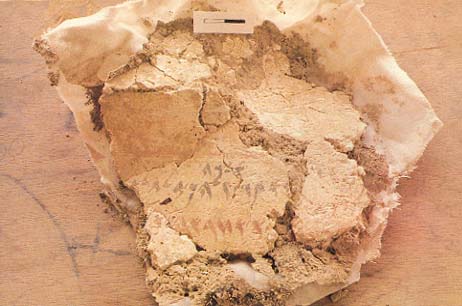
From the moment of discovery, each plaster fragment was carefully picked up, gingerly cleaned of any remaining clay, either by hand or with a very soft fine brush, and then put in a tin with a number. As soon as possible, infrared photographs of each fragment were taken; these made clearer the traces of organic ink on the plaster. The discovery seemed so important that, for the last two weeks of the season, the normal work of excavation ceased while everyone concentrated on the inscribed plaster fragments.
The news of the discovery spread quickly. One of the first visitors to the site was Lancaster Harding, director of the Jordanian Department of Antiquities. Paul Lapp, director of the American Schools of Oriental Research, and Père Roland de Vaux of the French École Biblique et Archèologique, prominent scholars from what was then Jordanian Jerusalem also came to participate in the excite meet. Eminent scholars from abroad, such as Germany’s Martin Noth and Holland’s P. A. H. de Boer also made their way to Deir Alla.
Soon, the first preliminary drawings of the inscriptions began to circulate, and a photograph of the largest inscribed fragment was published with a preliminary announcement in the international Biblical scholars review, Vetus Testamentum.2 The excitement in the Biblical community mounted with a rumor (that was later confirmed) that the inscribed plaster fragments contained a reference to “the seer Balaam, son of Beor,” so well known from the Bible (Numbers 22–24).
Following these sensational reports, slow, careful work began, to restore and conserve all the very brittle plaster fragments, some of them tiny. The restoration, conservation and analysis of the fragments was undertaken at the Central Research Laboratory for Objects of Art and Science in Amsterdam. After several years this work was completed. It took several more years to study, draw, reassemble and begin to read and understand the often faint traces of black and red letters. This work was done at the Institute of Palestinian Archaeology of the Rijksuniversiteit in Leiden. Then, in 1976, a magnificent book with facsimiles and pictures, both black-and-white and color, was published.3
By 1972, the inscribed plaster fragments had been arranged in two principal groups or combinations; scholars refer to these as Combination I and Combination II. Each of the two assembled combinations was strengthened by mortar on the back and put into a wooden frame. The frames were then sent to Jordan, where they are now on exhibit at the Amman Archaeological Museum.
Readers of BAR will not be surprised to learn that the publication of the 1976 book with facsimiles and pictures, what scholars call an editio princeps, was just the beginning, not the end, of the analysis of the inscriptions. Even now, nearly ten years after the editio princeps appeared, it is clear that there are still many problems with the inscription. However, little by little, as scholars have proposed various solutions, many aspects of the inscription and its importance to our understanding of Biblical literature are becoming clearer.
The time has now come for a more general treatment of the inscription, although many conclusions must remain somewhat tentative.
The first question concerns the date of the inscription. On this matter, a scholarly consensus is developing within a surprisingly narrow range. In the preliminary announcement, the inscription was inexplicably dated to the Persian period (from the end of the sixth century to the fourth century B.C.). However, subsequent excavations on the tell itself by Moawiyeh Ibrahim of the Jordanian Department of Antiquities and Gerrit van der Kooij of the University of Leiden demonstrated that the archaeological stratum in which the inscribed plaster fragments were found was to be dated, on the basis of pottery, “in the eighth century B.C.”4 This eighth-century dating agrees with the results of radiocarbon dating tests. According to these tests, the inscriptions were to be dated c. 800 B.C., plus or minus 70 years, with a probability of 66% that the dating was within this range.5 Paleographical analysis—based on the shapes and forms of the letters—performed by Professor Joseph Naveh of Hebrew University supported this eighth-century B.C. conclusion. Professor Naveh classified the writing as a cursive Aramaic script to be dated “to the middle of the eighth century or even earlier (by one or two decades).”6
Recently, a few scholars have suggested lowering the date to the beginning of the seventh century B.C.7 Their suggestion is based on an alleged connection between the handwriting of the Deir Alla inscription and certain Ammonite inscriptions of the seventh century. However, the arguments for the mid-eighth-century dating seem to fit the evidence far better.
A mid-eighth-century date also provides an attractive historical context for the inscription. It is clear, even from the preliminary excavation report, that the archaeological stratum in which the inscribed plaster fragments were found was destroyed by an earthquake. This is hardly surprising in the Jordan Valley, where so many earthquakes have been recorded in historical periods. But this earthquake appears to have been particularly severe, producing numerous cracks and shifts in the archaeological strata. These cracks and shifts stopped, however, at the top of the stratum in which the fallen inscribed plaster fragments were found.
If this major earthquake is dated to the eighth century B.C.—more specifically, to the middle of the eighth century—it is very tempting to identify it with the famous earthquake that occurred about 750 B.C., during the reigns of King Uzziah of Judah and King Jeroboam II of Israel, mentioned in the book of the prophet Amos (Amos 1:1) and by Zechariah (Zechariah 14:4–5). Chapter one, verse one of the Book of Amos tells us that the “words of Amos” were given during the reigns of Uzziah end Jeroboam, “two years before the earthquake.” Zechariah, writing in the sixth century B.C., predicts that a day will come when the earth will shift and split and the valley of the Hill of Jerusalem will be stopped up as it was “as a result of the earthquake in the days of King Uzziah of Judah.” The eighth-century B.C. earthquake, probably felt throughout Palestine, may well account for the destruction encountered in strata of this date at a number of sites, for example, at Hazor and Samaria. Indeed, this same earthquake may have crumbled the plaster of the walls on which the inscriptions at Deir Alla were originally painted. In any event, the earthquake was of such magnitude that it was remembered two centuries later, as the quotation from Zechariah demonstrates.
Although the editio princeps suggested that the inscription was originally written on a stele, that is, a freestanding monument, a detailed analysis of the archaeological reports and of the shape of the plaster fragments seems to indicate that the inscription was written on white plaster that covered a mudbrick wall.8
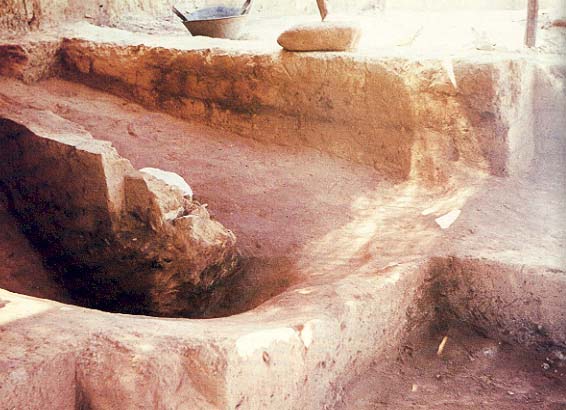
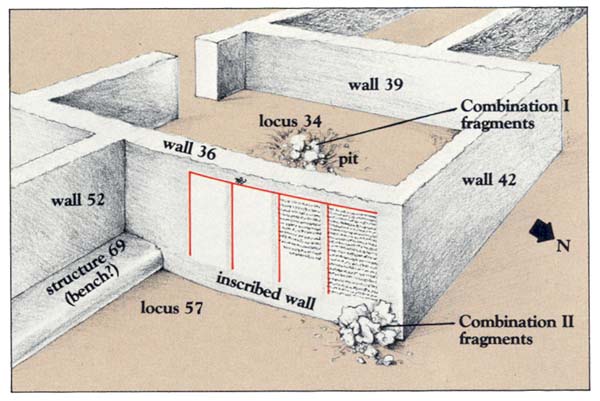
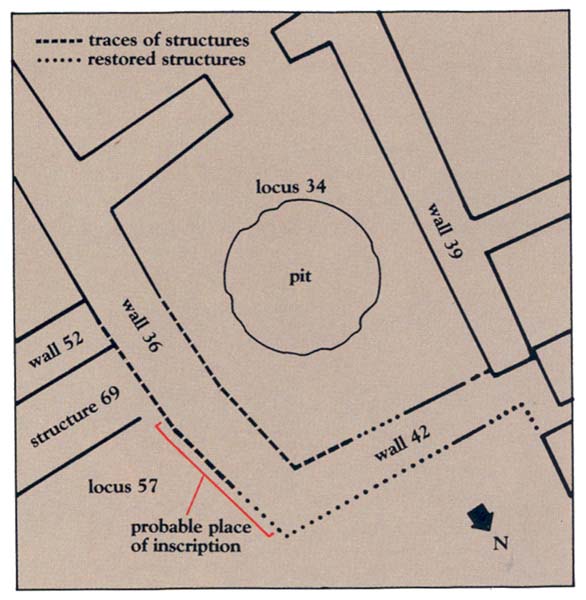
The loci, or exact locations, of the inscribed plaster fragments were carefully recorded by the excavators. This is important not only for dating purposes, but also because this helps to divide the fragments into two groups or combinations. One group was found in a pit in the middle of the floor of a room identified as locus 34. These fragments are designated Combination I. The other group was found outside the northeastern corner of the wall of the room (locus 57 on the plan), about ten feet from the first group. The second group is called Combination II. In dividing the fragments into two groups, the archaeologists considered not only each locus but also the possibility of fitting the pieces together. The fragments in Combination II are generally larger and in relatively better condition than those in Combination I. The inscription itself was probably originally painted on the eastern side of the wall identified on the plan as Wall 36, in the room adjoining locus 34, a conclusion based on the orientation of the fragments as they were found in the excavation. Although the fragments in Combination I were found on the other side of Wall 36, it is likely that they, too, were part of the inscription painted on the eastern face of Wall 36. Although the two major combinations lay at extreme ends of the excavation area containing the inscribed fragments, smaller groups and single pieces9 were scattered throughout the intervening area, so all fragments probably originally came from the same wall. Apparently when the wall on which the inscription was written collapsed, part of the wall fell into the adjoining room.
The very regular, careful handwriting of the inscription is easily identified as that of a professional scribe. The scribe followed guiding lines and used beautiful thick and thin strokes in his letters. The general aspect gives us the feeling that we are standing before a column of a manuscript. This feeling is heightened by the fact that the scribe used red ink for the title and for the most important sentences of the text he was copying, and black ink for the rest of the text. And he wrote within a frame: A large red horizontal line marks the upper limit of the inscription, and another vertical red line on the left side of the inscription marks the end of the column. (Remember that this inscription is written from right to left.) This frame at the top and on the left of the inscription brings to mind the preparations scribes customarily made before copying a column of manuscript. The use of red ink for the framing, the title and the principal passages of a manuscript was already well known by this time in Egypt; this cultural influence was no doubt clearly felt in Palestine. Indeed, the etymology of the word rubric includes the meaning red, a meaning that derives from the use of red ink in antiquity to mark off topical sentences, as was done in the Deir Alla inscriptions.
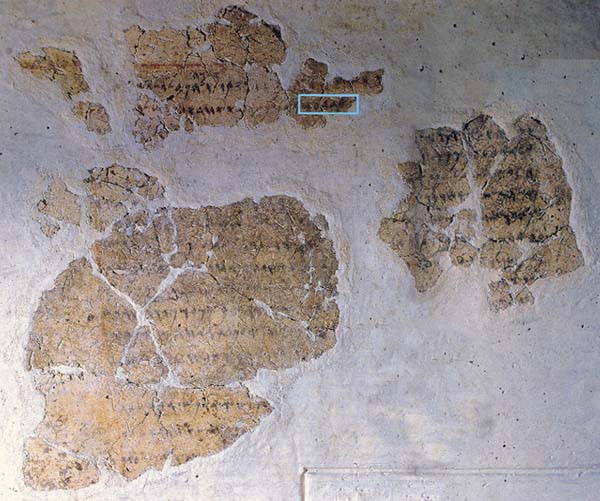
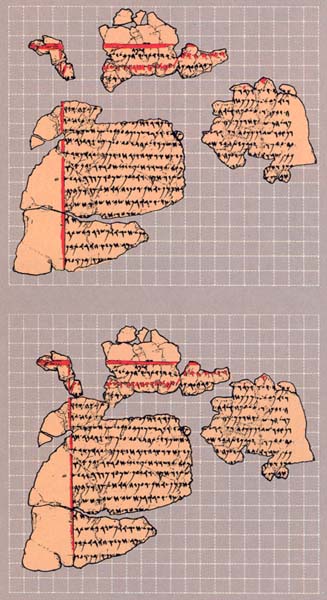
Although we cannot be sure, several details hint that four red frames had been painted on this wall, but at the time of the earthquake only one and a half frames had been partially filled. Combination II was written at the bottom of the first column and Combination I at the top of the second column, counting the columns from right to left.
Each column was about 15 ½ inches wide, as indicated by the width of surviving lines of writing (12 ¼ inches) plus surviving margins between the writing and the red frame (3 to 3 ½ inches). Each line of writing contained about 48 letters. It appears from the vestiges of the red framing that the height of the columns was probably between two and three feet. All of these factors suggest that the writing on the wall was a copy of a manuscript writ large.
This inscription, as we have reconstructed it, provides us with what is probably the best example we have of the appearance of an eighth-century B.C. northwest Semitic manuscript in Aramaic, Phoenician or Hebrew. At that time, the differences among these three scripts were minimal, so the Deir Alla inscription allows us to visualize in a very concrete way the appearance of original Biblical books, for example, the books of the prophets Amos and Hosea, who lived in the eighth century B.C.
What about the content of this inscription? What does it say? To read the inscription, we must first decide how its pieces should be fit together. The editio princeps provided a major first step in solving the puzzle. The large pieces of Combination II found near the wall were easily put together; however, this did not result in restoring a single complete line. Even today, we can read but a few words and phrases of Combination II. The reading of the text and its interpretation are still very uncertain. We can only conjecture about the general ideas the text covers, and these ideas vary from commentator to commentator.
Combination I consists of numerous small fragments, many of them tiny. As a result, restoration work is more difficult than with the larger pieces of Combination II. Despite the difficulty, however, restoration of Combination I has been far more successful. In the editio princeps, Professor van der Kooij succeeded in restoring four groups that made up different parts of Combination I. He could not, however, position these groups in relation to one another; that is, he could not connect any of his four groups. Shortly after the editio princeps was published, Professor André Caquot of the College de France, Paris, and I10 successfully demonstrated the vertical connection between these four groups. Other studies, including one by P. Kyle McCarter, Jr.,11 and another by Jo Ann Hackett,12 helped to place other small fragments. Thus it is now possible to restore the beginning of the first line, a restoration with which all scholars now agree.
These first words, written in red ink, were actually the title of that part of the text:
S
ù Pù Rù [B]Lù ‘ù Mù [.BR B‘]R. ’Sð .H|Zù H. ’LHNù
“Inscription/text/book of [Ba]laam [son of Beo]r, the man who was a seer of the gods.”
(The italics indicate that the letters are damaged; consequently, the proposed reading is probable, but given with some caution. The letters in brackets are probable restorations of missing letters.)
There is little doubt that this is the same Balaam, son of Beor, whose oracles are preserved in Numbers 22–24! Here we have the title of the inscription written in red. Although the name Balaam, son of Beor, in the title is partially reconstructed (“Ba” in “Balaam” and most of “son of Beor” are missing), the second line does much to confirm this reconstruction; nearly the full name appears in line 2 (“son of Beor” is complete and the “m” in “Balaam” has survived. In line 3, “Balaam” is complete, and in line 4 “Balaam son of Beor” is complete.
The text goes on to describe a divine vision that came to Balaam at night, probably in a dream: “Lo, the gods came to him at night” and spoke to him (line 1). The content of the vision is frightening: his people are to be chastised, punished by a “fire of chastisement” that appeared to Balaam in his vision (line 2). The next day Balaam arose. “He could not eat and he wept” (line 3). “His people came to him and said to Balaam, son of Beor: ‘Why do you fast and why do you weep?’” (line 4).
Balaam describes for his people the calamity that is to come (line 5); the gods “have fixed a date” (line 6a).
What is foretold next is not entirely clear. It appears that the gods13 have instructed Shamash,14 the sun god, to “shut the skies” (the rays of the sun) with a “cloud”:
“There, let there be darkness” (line 6b). The darkness will “provoke terror” (line 7). A variety of birds in the sky will multiply as the sun disappears. The text becomes obscure, and then breaks off. Perhaps by execrations or other forms of magic, Balaam attempted to avert the disaster. One commentator, Baruch Levine,15 has suggested that Balaam was successful and that therefore his deeds were memorialized in the manuscript copied on the wall.
Balaam’s vision recalls several prophetic texts in the Bible that announce and describe the coming of the “day of the Lord,” a day of judgment accompanied by a final disaster. See, for example, Isaiah 13:9–11:
“Lo! The day of the Lord is coming
With pitiless fury and wrath,
To make the earth a desolation,
To wipe out the sinners upon it.
The stars and constellations of heaven
Shall not give off their light;
The sun shall be dark when it rises,
And the moon shall diffuse no glow.
And I will requite to the world its evil,
And to the wicked their iniquity;
I will put an end to the pride of the arrogant
And humble the haughtiness of tyrants.”
Another example may be found in Joel 2:1–3:
“Blow a horn in Zion,
Sound an alarm on My holy mount!
Let all dwellers on earth tremble,
For the day of the Lord has come!
It is close—
A day of darkness and gloom,
A day of densest cloud
Spread like soot over the hills.
A vast enormous horde—
Nothing like it has ever happened.
And it shall never happen again
Through the years and ages.
Their vanguard is a consuming fire,
Their rear-guard a devouring flame.
Before them the land was like the Garden of Eden,
Behind them, a desolate waste:
Nothing has escaped them.”
In the Deir Alla text, we read that “The gods came to him [Balaam] at night and spoke to him.” In Numbers, we also read that “God came to Balaam [after he had invited his visitors to spend the night] and … God said to Balaam” (Numbers 22:9, 12).
In the Deir Alla text, we read that, after receiving his night vision, “Balaam arose the next day.” In Numbers 22:13, we read that “Balaam arose in the morning.” The Biblical author was no doubt familiar with the Transjordanian Balaam tradition and even used what appears to be the same stereotyped narrative formulas that appear in the Deir Alla inscription.
The language or dialect of the Deir Alla text is still a matter of dispute among scholars. The language is clearly northwest Semitic, but which one? The identification is made more difficult by the fact that the inscription is probably a copy of a manuscript that was already decades or perhaps centuries old when it was copied on the wall at Deir Alla. Moreover, the text itself had been edited, or redacted, over a period of time, incorporating linguistic characteristics from the period of redaction.
Some commentators think the language is a Canaanite dialect close to Hebrew and Ammonite. Others, with whom I agree,16 believe it to be an old Aramaic dialect probably used in southern Syria and in northern Transjordan. The many archaic features of old Aramaic revealed in the text suggest that it was edited hundreds of years before this version was copied on the plaster wall at Deir Alla.
If we are right in thus classifying the language, the Deir Alla inscription provides us with the earliest literary text in old Aramaic. Indeed, we have two such texts, Combination II as well as Combination I. I believe these are two different texts. The story of Balaam begins only with Combination I, with its explicit title at the beginning of line 1. Combination II, which was written on the wall before Combination I, does not mention Balaam and is probably a copy of another literary text that, unfortunately, we cannot yet understand.
Why were these literary, probably religious, texts copied on the plaster wall of a room at Deir Alla? Maybe because the building was close to a temple or cult place. Although, as I noted earlier, Deir Alla has often been identified, especially in rabbinical tradition, as Succoth, a close analysis of the topographical geography of this part of the country suggests that Deir Alla should be identified with Penuel,17 where Jacob wrestled with the angel and where there was probably some cultic tradition (see Genesis 32:25–32). This same identification is supported by the references to Penuel in the story of Gideon in Judges 8.
Another reference in the Gideon story indicates that some people of the middle Jordan Valley were literate at least from the 11th century B.C.—a young man at Succoth wrote down a list of 77 elders and officials (Judges 8:14)
But this demonstrates literacy; it does not explain why the inscription was written on a wall. If someone wanted to write a very important inscription to be kept in a sanctuary or official place, he would likely put it on a freestanding stele. A famous example of such a freestanding stele is the Moabite Stone, inscribed by the Moabite king Mesha in the ninth century B.C. Apparently, however, writing on walls was not uncommon at this time. We have another example at Kuntillet Ajrud,18 a site recently discovered in Sinai. Religious inscriptions found there date from the first half of the eighth century B.C.,19 roughly the same time as the Deir Alla inscription. At Kuntillet Ajrud, in addition to inscriptions and drawings on storage jars, several inscribed plaster fragments written in Phoenician and Hebrew, in black and red ink, were discovered on a wall of a building at this desert site. At Deir Alla, a sphinx was drawn above the frame of one of the inscriptions (part of the head of this sphinx has not survived). At Kuntillet Ajrud, too, the inscriptions are sometimes accompanied by drawings. Several abecedaries (alphabets) were written on the storage jars at Kuntillet Ajrud; a fragmentary abecedary incised on a pottery sherd was discovered at Deir Alla. All this probably means that Kuntillet Ajrud and Deir Alla were both sites where some kind of teaching, writing and drawing occurred, that is, where some kind of religious “school” was maintained. At Deir Alla we have literary and probably classical texts that could well have been used for teaching purposes in this room.
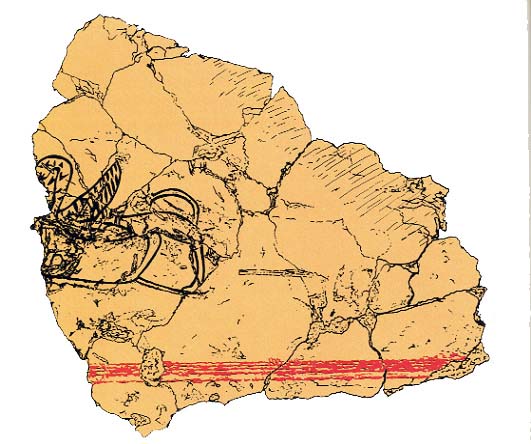
This interpretation is supported by allusions in several Biblical passages. For example, in a famous passage in Deuteronomy (6:9), the Israelites are directed to write the commandments of the Lord “on the doorposts of your house and on your gates.” (Jews still fulfill this instruction by attaching mezuzahs—pieces of parchment inscribed with this Biblical passage, and enclosed in cases—to the door-posts of their homes.) In Joshua 8:32 we learn that Joshua inscribed the teachings of Moses on plastered stones beside the altar he built on Mt. Ebal in fulfillment of the directions previously given by Moses and the elders in Deuteronomy 27:2–3. In the passage from Deuteronomy, the people are instructed to “set up great stones and plaster them over” before inscribing them. A kind of school for prophets is alluded to in 2 Kings 6:1–2, where the prophet Elisha’s students complain about their cramped quarters.
Despite these difficulties, the inscription from Deir Alla, dated to about the middle of the eighth century B.C. and written on the wall of what may have been some kind of religious teaching center, is very likely the earliest extant example of a prophetic text. The principal personage in the Deir Alla text is the seer Balaam, son of Beor, well known to us from the stories in Numbers. Balaam clearly appears as a foreigner in these Biblical stories; the ancient Hebrew scribes who wrote the Biblical stories about Balaam no doubt had some familiarity with old Aramaic literature, including the Aramaic book of the seer Balaam, son of Beor. Unfortunately, the Deir Alla fragments allow us to restore only a very small part of this book.
MLA Citation
Endnotes
Extract from the archaeological notes published in Jacob Hoftijzer and Gerrit van der Kooij, Aramaic Texts from Deir ‘Alla (ATDA), (Leiden, 1976), p. 18.
Henk J. Franken, “Texts from the Persian Period from Tell Deir ‘Alla,” Vetus Testamentum (VT) 17 (1967), pp. 480–481.
Moawiyeh Ibrahim and van der Kooij, “Excavations at Tell Deir ‘Alla, Season 1979,” Annual of the Department of Antiquities of Jordan 23 (1979), p. 50.
Joseph Naveh, “The Date of the Deir ‘Alla Inscription in Aramaic Script,” Israel Exploration Journal 17 (1967), pp. 256–258.
Cf. André Lemaire, “La disposition originelle des inscriptions sur plâtre de Deir ‘Alla,” to be published in Studi epigrafici e linguistici (SEL) 2 (1985).
P. Kyle McCarter, Jr., “The Balaam Texts from Deir ‘Alla: The First Combination,” Bulletin of the American Schools of Oriental Research 239 (1980), pp. 49–60; cf. also Baruch A. Levine, “The Deir ‘Alla Plaster Inscriptions,” Journal of the American Oriental Society 101 (1981), pp. 195–205.
The word is shaddayin, the plural of the related Hebrew word shadday, which is usually translated “Almighty” as in El-Shadday, “God Almighty.” The philological evidence seems to indicate that shadday originally meant “the one of the mountains”; that is, a mountain god. The plural used at Deir ‘Alla may refer to a divine council where major decisions were made.
Only the initial phoneme sh is extant. I have reconstructed Shamash on the basis of the disappearance of the sun suggested in the text. Another reconstruction, suggested by P. Kyle McCarter, Jr., is Sheol, goddess of the underworld and, in rabbinic literature, the realm of the underworld.
Cf. Lemaire, “La langue de l’inscription sur plâtre de Deir ‘Alla,” to be published in Comptes Rendus du Groupe Linguistique d’Etudes Chamito-Sémitiques.
Cf. Lemaire, “Date et origine des inscriptions hébraïques et phéniciennes de Kuntillet Ajrud,” SEL 1 (1984), pp. 131–143. See “Who or What Was Yahweh’s Asherah?” BAR 10:06, by André Lemaire.



